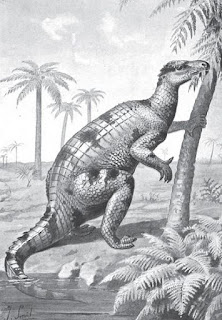 |
| Incorrect view of Iguanodon |
As only the second Dinosaur to be
discovered, Iguanodon reflects the development
of the science of paleontology. In fact when She was named by Gideon Mantell in
1825, “Dinosaurs” were still an unknown concept. He had named Her for her
iguana-like teeth, and regarded her “thumb” spike to be a nose horn similar to
an Iguana.
In 1842, Sir Richard Owen, a
creationist, in order to rebut various theories of evolution, created the
Dinosaur Order (Dinosauria) from Iguanodon, Megalosaurus, and Hylaeosaurus.
In contrast to the prevailing thought that these extinct animals were Reptiles,
Owen reconstructed Iguanodon as a
huge four-footed Mammal. Meanwhile, Mantell had the revolutionary concept that Iguanodon was a plant eater, when naturalists
at this time regarded Dinosaurs to be only giant carnivores.
These varying images formed the
first pictures of Iguanodon for the
public. Depicted as a lumbering low-slung animal, Iguanodon was displayed with her “thumb” spike on her nose. The
life-size reconstruction of Iguanodon,
at the Crystal Palace in London in 1852, resembled an Elephant with sharp
teeth. This particular depiction of her became firmly entrenched in the
public’s mind.
This image changed in 1878, when a
group of Iguanodon fossils was
discovered in a mine in Belgium. When these fossils were finally reconstructed,
scientists realized that Iguanodon
looked much different from what they initially thought. In his models, Louis
Dollo presented her new image to the public. Resembling a giant Wallaby, Iguanodon stood upright on her hind
legs, while balancing on her long tail. Dollo moved her nose horn to the end of
her hand for her “thumb” spike. Dollo’s presentation of Her lasted for an
hundred years.
In the 1980s as paleontologists
re-examined their ideas of Dinosaurs, they realized that they were wrong about Iguanodon. If She had sat on her tail, it would have broken in two. Meanwhile, other
new discoveries revealed that Dinosaurs had stiff tails that they held high off
the ground. Having a stiffened tail meant that Iguanodon could walk on two feet or four feet, as She chose. Since Iguanodon could do this, She could search
for both low lying plants and ones at the tree tops.
No comments:
Post a Comment